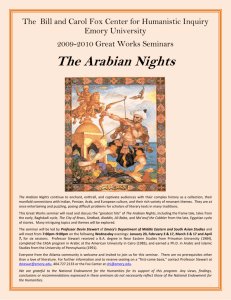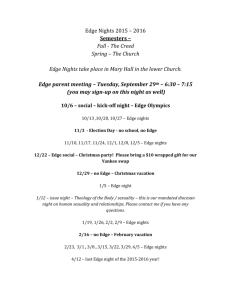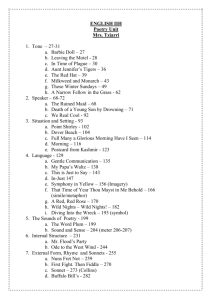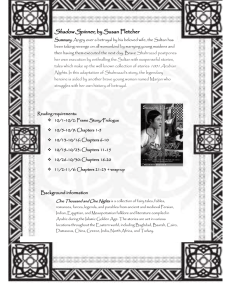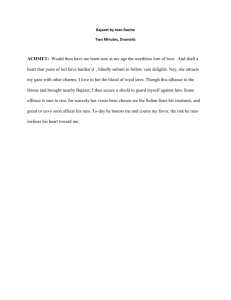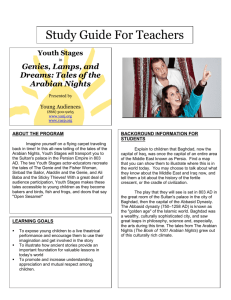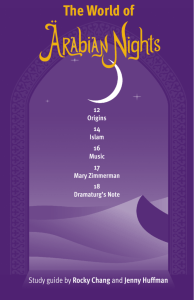Arabian Nights: History, Narrative, and Themes
advertisement
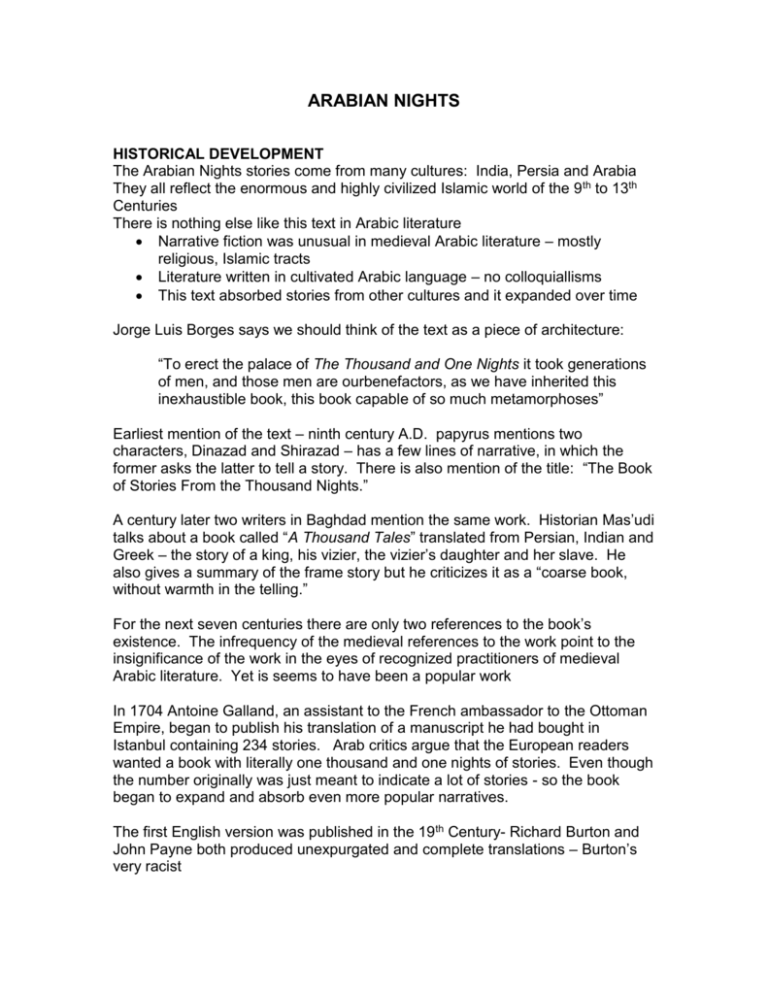
ARABIAN NIGHTS HISTORICAL DEVELOPMENT The Arabian Nights stories come from many cultures: India, Persia and Arabia They all reflect the enormous and highly civilized Islamic world of the 9 th to 13th Centuries There is nothing else like this text in Arabic literature Narrative fiction was unusual in medieval Arabic literature – mostly religious, Islamic tracts Literature written in cultivated Arabic language – no colloquiallisms This text absorbed stories from other cultures and it expanded over time Jorge Luis Borges says we should think of the text as a piece of architecture: “To erect the palace of The Thousand and One Nights it took generations of men, and those men are ourbenefactors, as we have inherited this inexhaustible book, this book capable of so much metamorphoses” Earliest mention of the text – ninth century A.D. papyrus mentions two characters, Dinazad and Shirazad – has a few lines of narrative, in which the former asks the latter to tell a story. There is also mention of the title: “The Book of Stories From the Thousand Nights.” A century later two writers in Baghdad mention the same work. Historian Mas’udi talks about a book called “A Thousand Tales” translated from Persian, Indian and Greek – the story of a king, his vizier, the vizier’s daughter and her slave. He also gives a summary of the frame story but he criticizes it as a “coarse book, without warmth in the telling.” For the next seven centuries there are only two references to the book’s existence. The infrequency of the medieval references to the work point to the insignificance of the work in the eyes of recognized practitioners of medieval Arabic literature. Yet is seems to have been a popular work In 1704 Antoine Galland, an assistant to the French ambassador to the Ottoman Empire, began to publish his translation of a manuscript he had bought in Istanbul containing 234 stories. Arab critics argue that the European readers wanted a book with literally one thousand and one nights of stories. Even though the number originally was just meant to indicate a lot of stories - so the book began to expand and absorb even more popular narratives. The first English version was published in the 19th Century- Richard Burton and John Payne both produced unexpurgated and complete translations – Burton’s very racist The stories seem to reflect life in the late medieval period in the Arab Islamic world – in particular popular notions about how a Turkish sultan would live in the fifteenth century. Ornate palaces, gardens, wine drinking, cup bearers and slave consorts resemble the court society of the Ottomans – a period sometimes seen in Arab culture as one of cultural decadence. In literature and art, it is a time of cultural vitality One of the interesting elements of the text is that it has a cross-cultural history and identity. However, critics will always make a point of citing which translation and which edition they are using to acknowledge the debate about what constitutes the original and the expanded version of the Arabian Nights NARRATIVE STYLE Folk Story Tradition Secular literature, historically not approved by the cultured literary class as literature at all. Stories are extremely varied – jam-packed with spiritual as well as earthly values, good and bad rulers, magicians and witches, sex, violence and good and bad jinnis, humans turning into animals and vice-versa. Always an underlying message about how to treat people and how to live your life Frame Story Two brother kings Shahraya and Shahzaman Shahzaman finds his wife having sex with the cook Kills them both, throws them over the palace wall Travels to his brother’s house to cheer up Sees his brother’s wife having sex with a slave and all her slave girls having sex with black slaves Shahrayar kills his wife and all the slaves, decides all women are untrustworthy Will sleep with a young woman for one night only and then kill her before she can cuckold him Kills many of the young women Vizier’s daughter, Shahrazad, offers to marry Shahrayar and try to trick him into not killing her or any more young women by telling him stories. Her younger sister must come along as a prop to ask her to keep telling the stories until he catches the bait Vizier tells her a story as a warning – but she does not listen – the ox and the donkey – if you try to help someone by trickery you will suffer too THEMES Power of story-telling – healing, educating, entertaining Women not just dangerous, untrustworthy, can use their intelligence and creativity and even deceitfulness for the good man powerless women – slaves and concubines faithful and faithless women sexually active women magicians and witches Power of kings Djinns and monsters Animals and humans Justice and forgiveness The demon is like the king in demanding blood for blood justice, shahrazad is no more responsible for what the king’s first wife did than the merchant is for innocently scattering date pits, one of which killed the demon’s son In both cases, a new, better kind of justice must be taught. The stories in the first set teach justice with forbearance. Evil people are turned into deer and dogs, not killed and the innocent merchant is set free, thanks to the three old men
